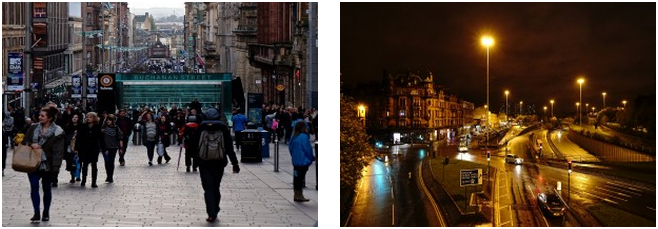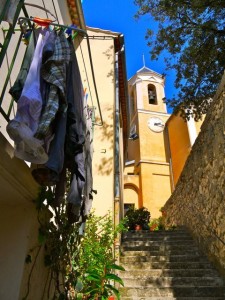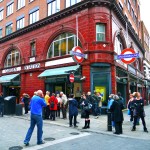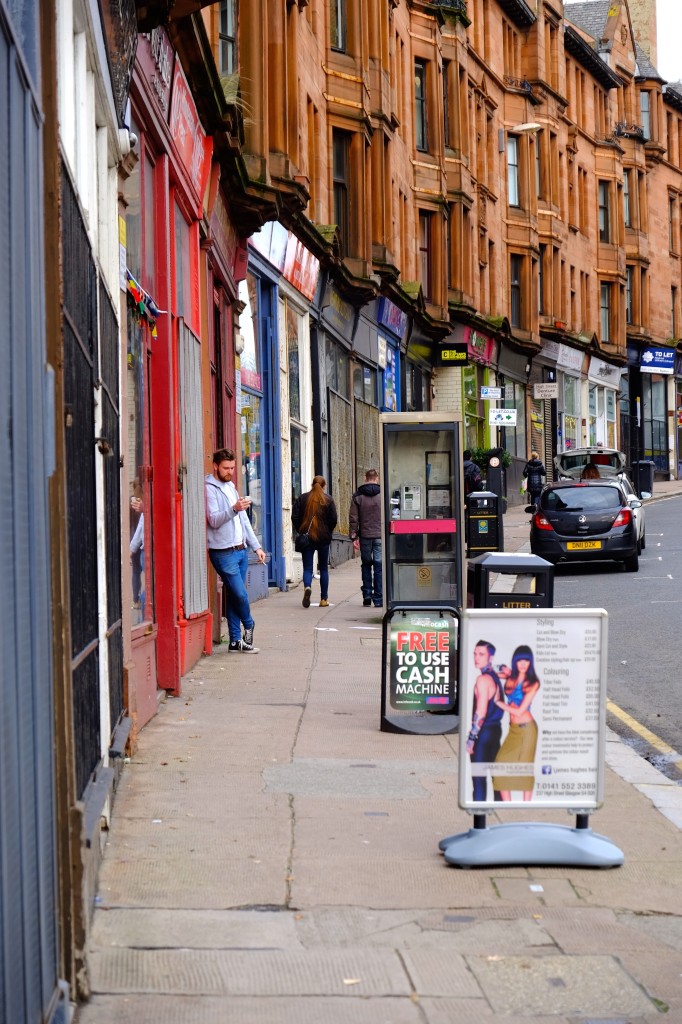A week’s residency in Glasgow, Scotland returns a 2011 essay to the forefront, and its message: In the post-freeway world, recall the important, organic landscape of neighborhood, towers and spires, lost before we can remember.

Among the more memorable aspects of my professional residence in Glasgow, Scotland this week are the readily ascertainable contexts of different streets from different eras. Dramatic contrasts emerge in a walk west from the remains of the historic, medieval High Street, across the pedestrian shopping promenades of Buchanan and Sauchiehall Streets, to the channeled traffic and amplified sounds of the M8 motorway system that transformed Charing Cross.
It’s a walk worth taking, as shown above, for a ready reference to the ebb and flow of the urban land use and transportation relationship over time.
Most importantly, this walk from High Street to the M8 provided new relevance for some of my earlier essays. While written for general applicability, the one reproduced below (posted both here and in The Atlantic in September, 2011) seems particularly relevant.
Some of the best thoughts about tomorrow’s urbanism come from yesterday’s observations.
A case in point is a quick-read essay entitled “The Discovery of the Street,” by J.B. Jackson (1909-1996), one of the twentieth century’s most noted commentators on the American landscape.
Jackson tells us what is organic, wondrous and ethereal about life in cities, through a bittersweet history of public space, from medieval markets to the modern freeway.
No matter that the Jackson piece is “legacy” in form and only partially internet-accessible (preview here in Glazer and Lille, The Public Face of Architecture). Jackson’s classic writing spins a most relevant story, an ambiguous tale about the raison d’être of today’s urbanism: reclaiming the human and natural systems which underlie the city, as first principles of urban reemergence from within, rather than sprawl to afar.
 According to Jackson, likely writing in the 1970’s, the symbol of the modern city is a collection of streets as seen from above, a mere “cartographic abstraction” of implied richness, because the bird’s-eye relationship between public byways and private space is how we now understand urban areas. In contrast, Jackson described the foundational and compact, vertical city of towers amid a landscape perceived by the medieval resident of long ago—who did not need to understand public streets and spaces—while living a straightforward human and animal-propelled life of short journeys to work, church, market and neighbors.
According to Jackson, likely writing in the 1970’s, the symbol of the modern city is a collection of streets as seen from above, a mere “cartographic abstraction” of implied richness, because the bird’s-eye relationship between public byways and private space is how we now understand urban areas. In contrast, Jackson described the foundational and compact, vertical city of towers amid a landscape perceived by the medieval resident of long ago—who did not need to understand public streets and spaces—while living a straightforward human and animal-propelled life of short journeys to work, church, market and neighbors.
The medieval, vertical city, however imperfect, was represented by an idealized symbol of the divine (a religious construct), “miniature versions of a celestial prototype: a walled city divided by two intersecting streets into four quarters.”
Jackson’s essay came to mind in my recurring legal work over the past few years addressing responsibility for environmental cleanup and the nature of public and private ownership as related to highways, arterials, streets and alleys, and associated advocacy about who is fiscally responsible for assuring public safety adjacent to private places. I had consulted his work frequently long ago, in the context of my Master’s thesis and a later book chapter I wrote on neighborhood planning, summarized here.
 His masterful narrative focuses on the 11th century, and how laws, which once regulated classes of people (e.g. feudal lords, citizens, traders and merchants), evolved to regulate places. From the dawn of the geographically delineated, regulated marketplace through the evolution of transportation technology, advances such as the harnessing of multiple horses and pivoted front wagon axle resulted in the surrounding city taking on a different shape. Jackson recounts how forms of public assembly further developed, and streets and squares changed to accommodate both commerce and necessary vehicular space. Land became a commodity as lots to be created, measured and taxed, with buildings to be designed and regulated:
His masterful narrative focuses on the 11th century, and how laws, which once regulated classes of people (e.g. feudal lords, citizens, traders and merchants), evolved to regulate places. From the dawn of the geographically delineated, regulated marketplace through the evolution of transportation technology, advances such as the harnessing of multiple horses and pivoted front wagon axle resulted in the surrounding city taking on a different shape. Jackson recounts how forms of public assembly further developed, and streets and squares changed to accommodate both commerce and necessary vehicular space. Land became a commodity as lots to be created, measured and taxed, with buildings to be designed and regulated:
Almost at once the town authorities recognized the street as a versatile tool for exerting control. In one town after another ordinances regulated the height of buildings, the pitch of their roofs, even their design, which had to be suited to the social standing of the occupants. City building plans were detailed… In the additions to existing towns the dimensions of the lot were prescribed, and all houses were taxed on the basis of frontage. The fact that each house owned half the width of the street in front of it encouraged each business or each household to expand its activities on to the street and to use the space for its convenience. As a consequence the civic authorities legislated questions of health and safety….
People learned to perceive a new kind of public space where previously there had merely seen a succession of alleys and passageways, a crooked interval between houses. Now they discovered a continuous space with a quality—and eventually a name—of its own…
The main point for invoking Jackson today, is that in order to achieve a successful city—a place of congregation in the social science, rather than religious sense—we must understand the backstory of organic human association. We must further honor Jackson’s inquiry as to why stones and huts—density based on human association and interdependence—evolved into public and private spaces with the associated loss of a human scale.
 As his essay concludes:
As his essay concludes:
It was in this tentative and almost unconscious manner that the street in our European-American model began a career that became increasingly spectacular and then culminated in the freeway. Imperceptively and over many generations our vision of the city shifted from the cluster of towers and spires to the perspectives of avenues and streets and uniform-sized lots. The celestial model, never easy to discern in the dark medieval spaces among stone walls and crowded huts, has been at last forgotten; the map, the diagram, the coordinates are what help us to make sense of the city.
In my view, Jackson’s subtle synopsis ends with an ironic, yet nostalgic judgment of a milquetoast, mapped reality, He implies missed opportunities to create more ideal, scaled spaces which look across and upward rather than down from above.
Jackson might have spoken more directly, but, in my opinion, he invoked a laudable, now familiar challenge to the post-freeway world—to recall the importance of the organic landscape of neighborhood, towers and spires lost before we can remember.
Images composed by the author in Glasgow. Prior photos also composed by the author in Seattle and in Fayence and Annecy, France. Click on the images for more detail. © 2009-2014 myurbanist. All Rights Reserved. Do not copy.




